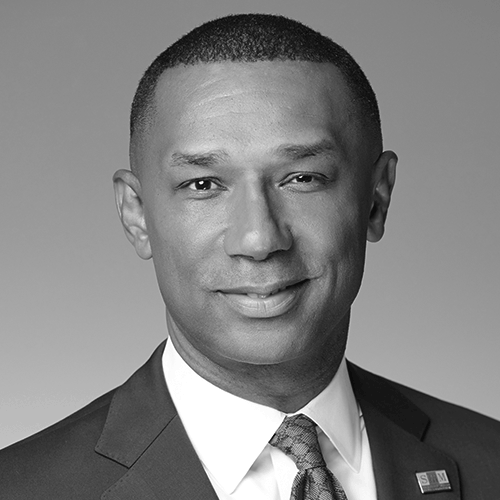Panelists Johnny C. Taylor, CEO of Society for Human Resource Management (SHRM) and Sudhir Tauro, Head of Employee Wealth Services with UBS Workplace Wealth explain why it’s important for companies to prioritize employees’ physical, mental, and financial wellbeing.

Johnny C. Taylor
CEO of Society for Human Resource Management (SHRM)
Why should organizations invest in their employees’ health and professional growth?
A public health crisis, an economic downturn, and social injustice has put an unprecedented amount of stress on employees. Employers must continue to step up and take care of their workforce holistically. Research tells us nearly one in four employees report feeling down, depressed, or hopeless often, and more than one in three employees report having done nothing to cope with their feelings. When we don’t feel our best, mentally or physically, we can’t perform our best. It’s that simple. As society wrestles with tremendous change, it’s time for employers to be there for employees, whether it’s providing timely and important resources, delivering professional growth opportunities, or offering counseling and other support, HR professionals can play an integral role in making workers feel safe, secure, and looked after. This will lead to a more productive and motivated workforce.
What are the biggest obstacle companies face during this time when trying to improve workplace wellness, engagement, and retention?
COVID-19 has further blurred the already hazy lines between work and home life, creating a new kind of blended reality. Research found 41 percent of employees are feeling burnt out, and 65 percent of employers say maintaining employee morale has been a challenge. In many ways, HR is quarterbacking this crisis, striving to strike the right balance between the dual needs of business and people, while doubling down on company values and principles in the process. What makes the challenge even more complex is that every employee is facing a situation that is unique and certainly new to them. And now, many workers are dealing with plans around schools reopening and how they will manage their workload and having children learning at home fulltime or on a modified school schedule. That’s a lot of pressure. Trust me, I know firsthand.
What is one industry trend that is helping to combat these major challenges?
HR leaders are recognizing this is a challenging time for all employees, so benefits and policies are adapting. Nearly all segments of the workforce have had to pivot, adapt, and evolve to meet the new normal, spurring organizations to rethink business practices and find new ways to innovate and tailor benefits to the new needs of a diverse workforce. We’re seeing this play out in quite a few different ways. For one, employers are offering greater flexibility in when, how, and where work gets done. In fact, SHRM research shows 68 percent of organizations will probably or definitely adopt broader, or more flexible, work-from-home policies. Additionally, we’ll see a greater focus on employees’ mental and physical health, including access to telemedicine for mental health services, wellness programs to manage stress, and expanded employee assistance programs. Above all, it’s important for HR and business leaders to be “extra” in taking more time to be empathetic, communicate, and check in with employees to make them feel seen and heard during these extraordinary times. There are many ways to tackle the new challenges the COVID-19 pandemic has brought to the table, but we can’t do that unless we’re prioritizing the needs of employees.

Sudhir Tauro
Head of Employee Wealth Services with UBS Workplace Wealth
Why should organizations invest in their employees’ health and professional growth?
Financial wellness programs help employees feel dramatically better about their financial well-being, which, in turn, positively impacts their overall health. A recent UBS study shows that 70 percent of program participants are confident they can achieve their financial goals, twice as high as non-participants. These programs generate higher employee satisfaction, motivation and loyalty, providing organizations a competitive edge in acquiring and retaining talent.
What are the biggest obstacle companies face during this time when trying to improve workplace wellness, engagement, and retention?
Awareness and understanding of [company] programs is key. The same UBS study found almost half of employees would choose to participate in their company’s financial wellness program if they knew about it. Furthermore, while most financial wellness programs offer a variety of tools and resources, they lack the necessary features to be effective and to encourage employee adoption.
What is one industry trend that is helping to combat these major challenges?
Due to COVID-19, employees of all ages and income levels are more interested in addressing their financial well-being. At UBS this year, we’ve seen a 700 percent increase in employee enrollment in wellness programs by their employers and a dramatic surge in employee demand, with triple the number of coaching appointments. Helping employees better manage their finances is becoming a critical workplace benefit.

